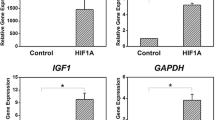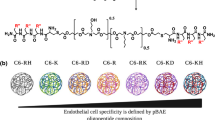Abstract
Vascular endothelium gene expression regulates blood-vessel wall interactions, vascular permeability, smooth muscle cell growth and tone. The possibility to introduce exogenous DNA or RNA sequences in endothelial cells represents a novel therapeutic approach of vascular disease. The aim of the work was to investigate the ability of endothelial cells to internalize and express exogenous DNA sequences. Human umbilical vein endothelial cells (HUVEC) were transfected with either a 780 bp fluorescein-labeled DNA (FITC-DNA) or pEGFP-C1 plasmid encoding for a green fluorescent protein (GFP), using the cationic liposome DOTAP as transfection reagent. The transfected cell population was passed through a FACScan apparatus and percentage of fluorescent cells was determined using a FACScan analysis programme. The SW620 tumor-derived cell line was used as control. The percentage of FITC-DNA positive cells was 66.0% for HUVEC and 45.0% for SW620 cells. On the contrary, the percentage of GFP-positive cells was 13.8% and 43% for HUVEC and SW620, respectively. By increasing the amount of DNA as well as the protocol of administration the percentage of GFP-positive HUVEC was enhanced suggesting a rapid degradation of DNA in the HUVEC cytoplasm.
Similar content being viewed by others
References
Haller H. Endothelial functions. General considerations. Drugs 1997; 53(Suppl 1): 1-10.
Schiffrin EL. The endothelium and control of blood vessel function in health and disease. Clin Invest Med 1994; 17: 602-620.
Ross R. Cell biology of atherosclerosis. Annu Rev Physiol 1995; 57: 791-804.
Schwartz SM, deBlois D, O'Brien ER. The intima. Soil for atherosclerosis and restenosis. Circ Res 1995; 77: 445-465.
Gibbons GH, Dzau VJ. Molecular therapies for vascular diseases. Science 1996; 272: 689-693.
Felgner PL, Ringold GM. Cationic liposome-mediated transfection. Nature 1989; 337(6250): 387-388.
Gao X, Huang L. Cationic liposome-mediated gene transfer. Gene Therapy 1995; 2: 710-722.
Strauss WM, Dawsman J, Beard C, Johnson C, Lawrence JB, Jaenisch R. Germ line transmission of a yeast artificial chromosome spanning the murine alpha 1 (I) collagen locus. Science 1993; 259: 1904-1906.
Zhu N, Liggitt D, Liu Y, Debs R. Systemic gene expression after intravenousDNAdelivery into adult mice. Science 1993; 261: 209-211.
Liu Y, Liggitt D, Zhong W, Tu G, Gaensler K, Debs R. Cationic liposome-mediated intravenous gene delivery. J Biol Chem 1995; 270(42): 24864-24870.
Simon RH, Engelhardt JF, Yang Y, et al. Adenovirusmediated transfer of the CFTR gene to lung of non human primates: toxicity study. Hum Gene Ther 1993; 4: 771-780.
Canonico AE, Plitman JD, Conary JT, Meyrich BO, Brigham HL. No lung toxicity after repeated aerosol or intravenous delivery of plasmid-cationic liposome complexes. J Appl Physiol 1994; 77: 415-419.
Citti L, Boldrini L, Nevischi S, Mariani L, Rainaldi G. Quantification of in-vitro activity of synthetic trans-acting ribozymes using HPLC. Bio Techniques 1997; 23: 898-903.
Sambrook J, Fritsch EF, Maniatis T, Ed. Molecular Cloning. A Laboratory Manual, 2nd ed. New York: Cold Spring Harbor Laboratory Publishing, 1989.
Mortimer I, Tam P, MacLachlan I, Graham RW, Saravolac EG, Joshi PB. Cationic lipidmediated transfection of cells in culture requires mitotic activity. Gene Therapy 1999; 6: 403-411.
Citti L, Eckstein F, Capecchi B, et al. Transient transfection of a synthetic hammerhead ribozyme targeted against human MGMT gene to cells in culture potentiates the genotoxicity of the alkylation damage induced by mitozolomide. Antisense & Nucleic Acid Drug Development 1999; 9: 125-133.
Gokhale PC, Soldatenkov V, Wang F-H, Rahman A, Dritschilo A, Kasid U. Antisense raf oligodeoxyriboncleotide is protected by liposomal encapsulation and inhibits Raf-1 protein expression in vitro and in vivo: implication for gene therapy of radioresistant cancer. Gene Therapy 1997; 4: 1289-1299.
Zabner J, Fasbender AJ, Moninger T, Poellinger KA, Welsh MJ. Cellular and molecular barriers to gene transfer by a cationic lipid. J Biol Chem 1995; 270(32): 18997-19007.
Yang J-P, Huang L. Overcoming the inhibitory effect of serum on lipofection by increasing the charge ratio of cationic liposome to DNA. Gene Therapy 1997; 4: 950-960.
Mounkes LC, Zhong W, Cipres-Palacin G, Health TD, [Debs RJ. Proteoglycans mediate cationic liposome-DNA complexbased gene delivery in vitro and in vivo. J Biol Chem 1998; 273(40): 26164-26170.
Brouland JP, Gilbert MA, Bonneau M, Pignaud G, Bal Dit Solier C, Drouet L. Macro and microheterogeneity in normal endothelial cells: differential composition of luminal glycocalyx and functional implications. Endothelium 1999; 6(3): 251-262.
Mislick AM, Baldeschwieler JD. Evidence for the role of proteoglycans in cationic-mediated gene transfer. Proc Natl Acad Sci USA 1996; 93: 12349-12354.
Tsan MF, Tsan GL, White JE. Surfactant inhibits cationic liposome-mediated gene transfer. Hum Gene Ther 1997; 8: 817-825.
Teifel M, Heine LT, Friedl M, Friedl P. Optimization of transfection of human endothelial cells. Endothelium 1997; 5: 21-35.
Fife K, Bower M, Cooper RG, et al. Endothelial cell transfection with cationic liposomes and herpes simplex-thymidine kinase mediated killing. Gene Therapy 1998; 5: 624-620.
Guy J, Dubravka D, Antoniou M. Delivery of DNA into mammalian cells by receptor-mediated endocytosis and gene therapy. Mol Biotechnol 1995; 3: 237-248.
Cotten M. High-efficiency receptor-mediated delivery of small and large (48 Kilobase) gene constructs using the endosome-disruption activity of defective or chemically inactivated adenovirus particles. Proc Natl Acad Sci USA 1992; 89: 6094-6098.
Coonrod A, Li F-Q, Horwitz M. On the mechanism of DNA transfection: efficient gene transfer without viruses. Gene Therapy 1997; 4: 1313-1321.
Tanner FC, Carr DP, Nabel GJ, Nabel EG. Transfection of human endothelial cells. Cardiovasc Res 1997; 35: 522-528.
Author information
Authors and Affiliations
Rights and permissions
About this article
Cite this article
Colombo, M.G., Citti, L., Basta, G. et al. Differential Ability of Human Endothelial Cells to Internalize and Express Exogenous DNA. Cardiovasc Drugs Ther 15, 25–29 (2001). https://doi.org/10.1023/A:1011154616992
Issue Date:
DOI: https://doi.org/10.1023/A:1011154616992




